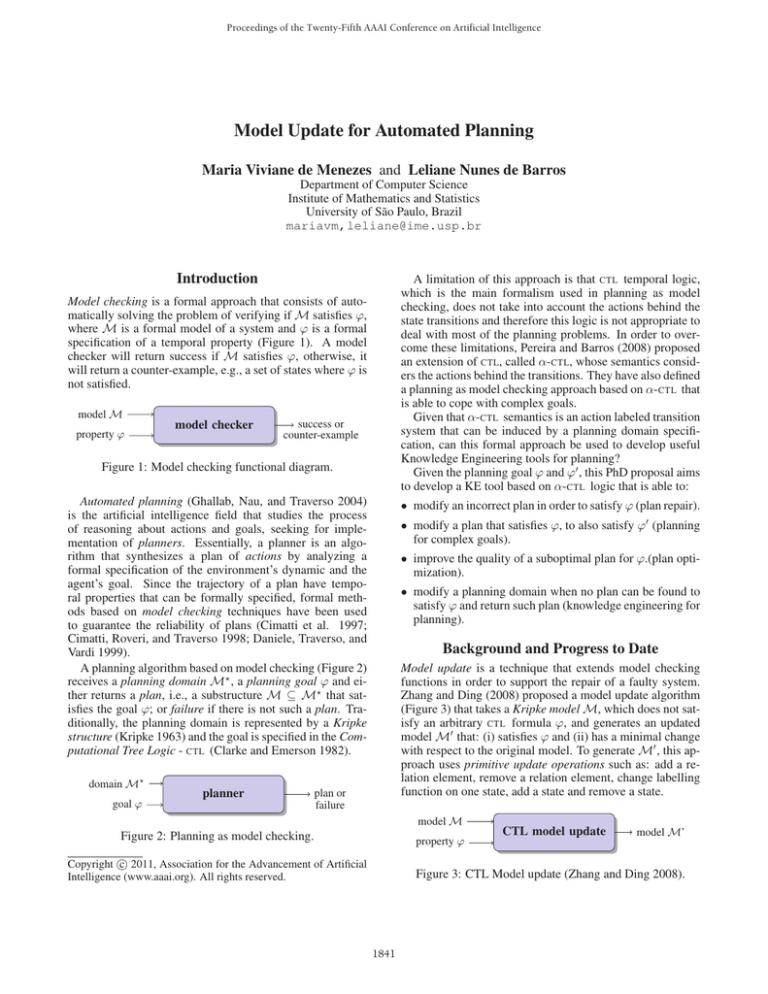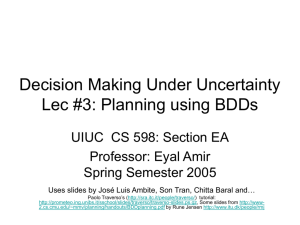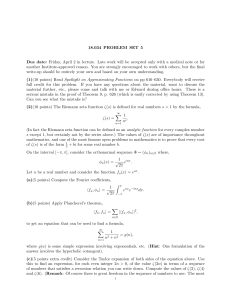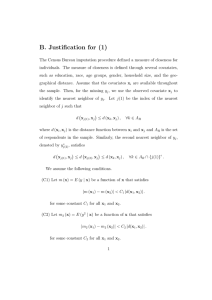
Proceedings of the Twenty-Fifth AAAI Conference on Artificial Intelligence
Model Update for Automated Planning
Maria Viviane de Menezes and Leliane Nunes de Barros
Department of Computer Science
Institute of Mathematics and Statistics
University of São Paulo, Brazil
mariavm,leliane@ime.usp.br
Introduction
A limitation of this approach is that CTL temporal logic,
which is the main formalism used in planning as model
checking, does not take into account the actions behind the
state transitions and therefore this logic is not appropriate to
deal with most of the planning problems. In order to overcome these limitations, Pereira and Barros (2008) proposed
an extension of CTL, called α-CTL, whose semantics considers the actions behind the transitions. They have also defined
a planning as model checking approach based on α-CTL that
is able to cope with complex goals.
Given that α-CTL semantics is an action labeled transition
system that can be induced by a planning domain specification, can this formal approach be used to develop useful
Knowledge Engineering tools for planning?
Given the planning goal ϕ and ϕ , this PhD proposal aims
to develop a KE tool based on α-CTL logic that is able to:
Model checking is a formal approach that consists of automatically solving the problem of verifying if M satisfies ϕ,
where M is a formal model of a system and ϕ is a formal
specification of a temporal property (Figure 1). A model
checker will return success if M satisfies ϕ, otherwise, it
will return a counter-example, e.g., a set of states where ϕ is
not satisfied.
model M
property ϕ
model checker
success or
counter-example
Figure 1: Model checking functional diagram.
Automated planning (Ghallab, Nau, and Traverso 2004)
is the artificial intelligence field that studies the process
of reasoning about actions and goals, seeking for implementation of planners. Essentially, a planner is an algorithm that synthesizes a plan of actions by analyzing a
formal specification of the environment’s dynamic and the
agent’s goal. Since the trajectory of a plan have temporal properties that can be formally specified, formal methods based on model checking techniques have been used
to guarantee the reliability of plans (Cimatti et al. 1997;
Cimatti, Roveri, and Traverso 1998; Daniele, Traverso, and
Vardi 1999).
A planning algorithm based on model checking (Figure 2)
receives a planning domain M , a planning goal ϕ and either returns a plan, i.e., a substructure M ⊆ M that satisfies the goal ϕ; or failure if there is not such a plan. Traditionally, the planning domain is represented by a Kripke
structure (Kripke 1963) and the goal is specified in the Computational Tree Logic - CTL (Clarke and Emerson 1982).
domain M
goal ϕ
planner
• modify an incorrect plan in order to satisfy ϕ (plan repair).
• modify a plan that satisfies ϕ, to also satisfy ϕ (planning
for complex goals).
• improve the quality of a suboptimal plan for ϕ.(plan optimization).
• modify a planning domain when no plan can be found to
satisfy ϕ and return such plan (knowledge engineering for
planning).
Background and Progress to Date
Model update is a technique that extends model checking
functions in order to support the repair of a faulty system.
Zhang and Ding (2008) proposed a model update algorithm
(Figure 3) that takes a Kripke model M, which does not satisfy an arbitrary CTL formula ϕ, and generates an updated
model M that: (i) satisfies ϕ and (ii) has a minimal change
with respect to the original model. To generate M , this approach uses primitive update operations such as: add a relation element, remove a relation element, change labelling
function on one state, add a state and remove a state.
plan or
failure
model M
Figure 2: Planning as model checking.
property ϕ
c 2011, Association for the Advancement of Artificial
Copyright Intelligence (www.aaai.org). All rights reserved.
CTL model update
model M’
Figure 3: CTL Model update (Zhang and Ding 2008).
1841
the size of the induced planning domain (M ). One possible way to deal with this is to work directly with the action
description (i.e., applying symbolic techniques).
We also intend to perform empirical experiments using
domains from the International Planning Competition (IPC6 2008). By analyzing (i) different plans generated by outof-shelf planners and (ii) planning problems for which no
planner is able to solve, we expect to be able to propose
updates either in the plans or in the planning domains.
Acknowledgements. This work has been supported by
FAPESP project 2010/10845-0.
Based on Zhang and Ding ideas, we propose an α-CTL
model update approach to perform knowledge engineering
for planning. The proposed system (Figure 4) receives: (i) a
set of actions A (used to induce the planning domain MA );
(ii) a partial model M, which is a substructure of the planing
domain (M ⊆ MA ) and represents the plan that we want to
update; and (iii) an α-CTL formula ϕ representing a planning
goal. The system will perform modifications in the input
model M to (Figure 4):
1. update M generating a plan M that satisfies ϕ or
2. update the planning domain MA in order to get such a
plan, if there is no plan that satisfies ϕ, generating a new
planning domain MA and a new set of actions A .
model M
actions A
property ϕ
α-CTL model
update
References
Cimatti, A.; Giunchiglia, F.; Giunchiglia, E.; and Traverso,
P. 1997. Planning via model checking: A decision procedure
for AR. In ECP, 130–142.
Cimatti, A.; Roveri, M.; and Traverso, P. 1998. Strong
planning in non-deterministic domains via model checking.
In AIPS, 36–43.
Clarke, E. M., and Emerson, E. A. 1982. Design and synthesis of synchronization skeletons using branching-time temporal logic. In LNCS - Logic of Programs, Workshop, volume 131, 52–71. London: Springer-Verlag.
Cresswell, S.; McCluskey, T.; and West, M. 2010. Acquiring planning domain models using LOCM. Knowledge
Engineering Review.
Daniele, M.; Traverso, P.; and Vardi, M. Y. 1999. Strong
cyclic planning revisited. In 5th European conference on
planning, 35–48.
Ghallab, M.; Nau, D.; and Traverso, P. 2004. Automated
planning: Theory and practice. USA: Morgan Kaufmann
Publishers Inc.
IPC-6. 2008. The 6th International Planning Competition.
http://ippc-2008.loria.fr/wiki/
index.php/Main_Page.
Kripke, S. 1963. Semantical considerations on modal logic.
J. Acta Philosophica Fennica 16.
Menezes, M. V.; Pereira, S. L.; and Barros, L. N. 2010.
Model Updating in Action. In Workshop on Knowledge Engineering for Planning and Scheduling – ICAPS.
Menezes, M. V.; Pereira, S. L.; and Barros, L. N. 2011. System design modification with actions. Advances in Artificial
Intelligence–SBIA 2010 31–40.
Wu, K.; Yang, Q.; and Jiang, Y. 2005. Arms: Actionrelation modelling system for learning action models. In
Proc. ICAPS, volume 5, 2003.
Zhang, Y., and Ding, Y. 2008. CTL Model Update for System Modifications. J. Artif. Int. Res. 31:113–155.
model M
actions A
domain MA
Figure 4: α-CTL Model Update.
In order to extend the CTL model update proposed by
Zhang and Ding (2008) for planning, we have also defined a
set of primitive operations, named Primitive Update in Action operations (PUAs for short). In (Menezes, Pereira, and
Barros 2011), we defined a set of four PAUs to update a plan
without modifying the planning domain, that are: PUA1
- adding transitions induced by an action; PUA2 - removing transitions induced by an action; PUA3 - adding a new
state; and PUA4 - removing an isolated state. In (Menezes,
Pereira, and Barros 2010), we defined three extra primitive
update operations to update a planning domain (i.e., to modify action specifications), that are: PUA5 - adding transitions
by relaxing an action precondition; PUA6 - adding transitions by adding an action effect; and PUA7 - removing a
transition by deleting only one of non-deterministic effects).
Formally, given a complete model M∗A induced by a set
of actions A; a partial model M ⊆ M∗A ; and an α-CTL formula ϕ defining a planning goal, the set of primitive update
operations PUA1-PUA4 can be used to refine and validate
the partial model M. If this is not possible, i.e., there is no
way to modify M to satisfy ϕ throughout PUA1-PUA4, then
the planning domain has to be updated by using operations
PUA5-PUA7.
Considering all the primitive update operations, PUA1PUA7, we have defined a minimal change criterion that is
able to suggest a set of minimal changes to the planning domain designer.
Discussion and Future Work
The main motivation for this work is to build a tool that can
support a knowledge engineer to specify a planning domain
for real applications where there is no guarantee to find an
optimal or correct plan solution.
Therefore, one of the challenges for future work is to define an α-CTL model update algorithm that is scalable with
1842








